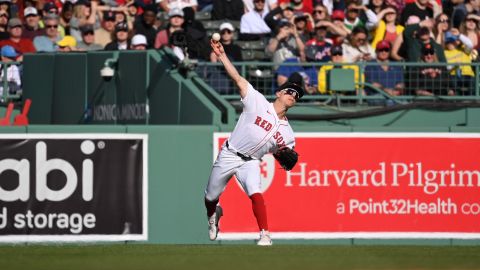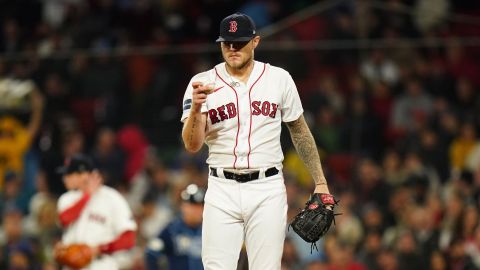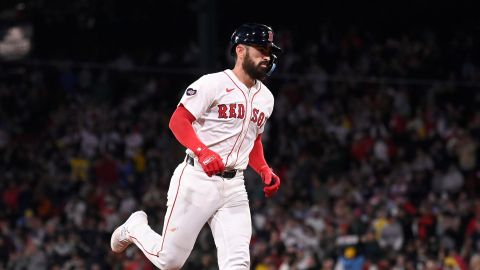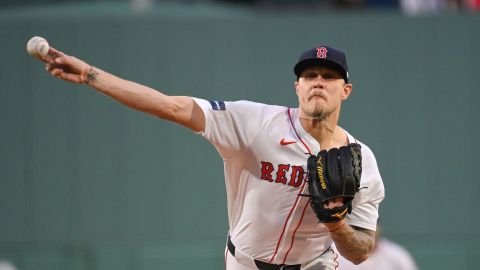For better or worse, the Boston Red Sox’s biggest July acquisition might be Rafael Devers.
Red Sox president of baseball operations Dave Dombrowski announced Sunday afternoon the Red Sox were promoting the 20-year-old third baseman to the major leagues, and Devers is expected to make his major league debut Tuesday night in Seattle.
It’s a somewhat curious decision for the Red Sox. After spending most of the spring and summer insisting they were going to take it slow with Devers, the decision to promote him comes a little more than a week after moving him to Triple-A Pawtucket. It’s an indication of just how dire the third base situation has been. Red Sox third basemen have a collective .596 OPS, worst in the majors, 20 points clear of the next worst club. It’s a black hole in the lineup for a team that’s won just four of its last 10 and holds just a 2 1/2-game over the recently improved New York Yankees.
But the trade market doesn’t look promising, and Devers is forcing their hand. He was fantastic in just nine games with the PawSox, hitting .400 (14-for-35) with two home runs.
So, what are the Red Sox going to get when the young Dominican Republic native joins them in the Pacific Northwest?
Devers is a natural at the plate. He’s one of the best prospects in all of baseball because of his bat. Devers is a big guy — 6-foot, 195 pounds — but doesn’t necessarily fit the offensive profile of a bigger player at that position. He’s got a smooth swing from the left side, but he’s not pull-happy, with the ability to spray the ball all over the park and the rare ability for someone his age to hit the ball with power to all fields.
He’s also quite polished for someone who, again, is just 20 years old. At Double-A Portland, Devers hit .282 with a .793 OPS against left-handers with six extra-base hits in 71 at-bats. In his first game after being promoted to Triple-A, Devers went 4-for-4 with his fourth hit being a home run off of left-handed reliever Neal Cotts, who has 483 career games of big league experience.
Just as important has been Devers’ ability to make contact at every level he’s reached. Devers’ strikeout rate remained consistent at 16 or 17 percent for much of his first four seasons in pro ball — even as a 16- and 17-year-old. League average at the big league level is just under 20 percent. It’s unrealistic to expect that number to hold steady, least early in his big league career. And it’s worth noting he did strike out in nearly a quarter of his limited Triple-A plate appearances, but if he can make relatively consistent contact at the big league level, that should help the transition.
If anything can be learned from Yoan Moncada’s promotion last season, it’s that expectations should be at least somewhat tempered and patience is important.
Boston promoted Moncada for the stretch run, and he struggled mightily, striking out in 12 of 20 plate appearances. But the swing and miss has been part of Moncada’s game since being signed and still is as evidenced by the 28.3 percent strikeout rate at Triple-A this season with the White Sox.
But while Devers won’t turn 21 until October, everyone who comes across him raves about how advanced he is for his age — ahead of even Moncada.
“(Devers is) way (more) advanced (than Moncada),” Portland manager Carlos Febles told The Boston Globe earlier this month. “Moncada was kind of a free swinger who would swing and miss a lot. That’s not Devers’ case. He has the ability to spread the field. When he’s at his best, he’s driving the ball all over the park, especially the other way.”
Defensively, Devers is at least a natural third baseman. Moncada, for instance, came up as a second baseman and made the move to third base. Devers is a big human, and he looks even bigger, but he has the natural ability to play an adequate third base — for now, at least. The range is OK, and the arm is good, although the four errors in eight games at Pawtucket jump off the page. But if the Red Sox are able to carry a glove-first replacement on the bench like Deven Marrero, they’ll have a late-game defensive replacement option.
The Red Sox are counting on Devers to come in and make an impact, and any production will be a marked improvement. He can help and probably should help. There’s some risk associated with putting too much pressure on someone so young, and as Moncada proved last year in a limited sample size, these transitions require time and more importantly, patience.
The Red Sox, in the thick of a pennant race, might not have much of either. Devers will get all the opportunities in the world to succeed. The Red Sox, with this move, are hoping that success comes sooner than later.
Thumbnail photo via Butch Dill/USA TODAY Sports Images




